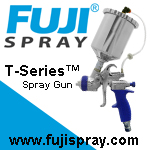Glue Spreader from Rockler
Your shop is probably filled with tools or accessories that you use all the time but never really give them much thought, I know mine is. Today we will take a look at one of those tools; The glue brush.
For years we have all used those little disposal acid brushes costing about 20 cents a piece. They work fine, so why change it?Well unless you spend the time washing them and picking out the dried glue bits, you throw them away just like I do. The first thing to consider is simply the cost. Counted up over a year or so it can add up some serious pocket change. In all honesty the cost is really the only factor that matters here, although living in a pro-recycling world we should pause to consider the number of dead brushes we all toss into your local land fills, working with a reusable brush will definitely cut that number down. Okay I know I am reaching for justifications but it really must be a lot of brushes,
Rockler has re-invented the glue brush with their new Silicone Glue Tool, a stylish blue and black, 7 ¼ inch brush. The brush end is made up of a 1 inch wide and ½ inch thick arrangement of bristles, perfect for getting glue on joint ends or even in dovetails. On the other end is a ½ inch paddle that can be used like a pen for finer detail work such as moldings, and for spreading glue into grooves and mortises.
![]() When I received a demo set of these brushes from Rockler, one was nice and clean and the other clogged with dried glue. Apparently Rockler wanted to have the brush all set up and ready to test. So test it I did. The glue chipped off easily, a gently wiggle of the bristles made the glue crumble off leaving the brush fairly clean even without washing. Then I decided I would try the same procedure using several types of glue.
When I received a demo set of these brushes from Rockler, one was nice and clean and the other clogged with dried glue. Apparently Rockler wanted to have the brush all set up and ready to test. So test it I did. The glue chipped off easily, a gently wiggle of the bristles made the glue crumble off leaving the brush fairly clean even without washing. Then I decided I would try the same procedure using several types of glue.
After a trip to Home Depot I arrived home with a bag full of glue bottles. I bought one of nearly every brand of glue they had. I had to laugh at my dedication to the test, that bag of glue cost me over $40 so I could test a $4 brush. The glues I am going to use in my test are; Titebond 2 and 3, Elmer’s Wood Glue Max, Gorilla Glue (both the normal type andthe wood glue) Armed with my glue and a pair of brushes I forged onward with my test. The plan was pretty simple I would coat the brushes with each glue, let them dry, and then try to clean it off.
I![]() started with Titebond 2 and 3. I coated the brushes and let the glue ooze in-between the bristles. Then I propped the brushes up so they wouldn’t adhere to the board where I was letting them dry. The next morning I took a look at the brushes and each of them was coated in a hardened mess of glue. I picked up the brush with the Titebond 2 and rubbed the bristle end in the palm of my have and the glue crumbled off leaving the brush nearly clear of the dried glue. Picking off the remainder of the glue the brush was now clean and ready for more. I did the same with the Titebond 3 brush and it cleared off just as well. Next I tried out the Gorilla Glue and the Gorilla Wood Glue. If any of these glues were going to give the brushes trouble it is the Gorilla Glue. After coating the brush with the normal Gorilla glue I ran some water on it to activate the glue. On the other brush I coated it with the Gorilla Wood Glue and let them both dry hard.
started with Titebond 2 and 3. I coated the brushes and let the glue ooze in-between the bristles. Then I propped the brushes up so they wouldn’t adhere to the board where I was letting them dry. The next morning I took a look at the brushes and each of them was coated in a hardened mess of glue. I picked up the brush with the Titebond 2 and rubbed the bristle end in the palm of my have and the glue crumbled off leaving the brush nearly clear of the dried glue. Picking off the remainder of the glue the brush was now clean and ready for more. I did the same with the Titebond 3 brush and it cleared off just as well. Next I tried out the Gorilla Glue and the Gorilla Wood Glue. If any of these glues were going to give the brushes trouble it is the Gorilla Glue. After coating the brush with the normal Gorilla glue I ran some water on it to activate the glue. On the other brush I coated it with the Gorilla Wood Glue and let them both dry hard.
![]() Once again when I checked them the next morning they were both hard as a rock. I went straight to the normal Gorilla Glue. The glue had foamed up nicely and didn’t budge with a preliminary flick of my thumb. Next I tried my previous trick and rubbed it in a circle on the palm of my hand but very little came off. After that I tried to pick the glue off a piece at a time and it pulled off fairly easily. The Gorilla Wood Glue came off just as easily as the Titebong glues did. The test on the Elmer’s Wood Glue went just as smoothly. These brushed performed just like Rockler said they would. But how do these brushes perform in applying glue to boards?
Once again when I checked them the next morning they were both hard as a rock. I went straight to the normal Gorilla Glue. The glue had foamed up nicely and didn’t budge with a preliminary flick of my thumb. Next I tried my previous trick and rubbed it in a circle on the palm of my hand but very little came off. After that I tried to pick the glue off a piece at a time and it pulled off fairly easily. The Gorilla Wood Glue came off just as easily as the Titebong glues did. The test on the Elmer’s Wood Glue went just as smoothly. These brushed performed just like Rockler said they would. But how do these brushes perform in applying glue to boards?
![]() Spreading the glue onto the side grain of a board it coated the glue very nicely. Next I tried it on a dado joint. Turning the brush sideways in the groove opf the dado it smoothed the glue along the dado nicely. The brush is aprox. 5/8 of an inch thick so it will travel through a ¾ inch dado with little trouble, although if the dado is smaller then 5/8 inch then the brush will not fit into the cut like the ¾ inch dado. This could be a problem if you were using those smaller dados. The other end of the brush is the paddle, it is thin enough to fit into those smaller slots to spread out the glue. The paddle end
Spreading the glue onto the side grain of a board it coated the glue very nicely. Next I tried it on a dado joint. Turning the brush sideways in the groove opf the dado it smoothed the glue along the dado nicely. The brush is aprox. 5/8 of an inch thick so it will travel through a ¾ inch dado with little trouble, although if the dado is smaller then 5/8 inch then the brush will not fit into the cut like the ¾ inch dado. This could be a problem if you were using those smaller dados. The other end of the brush is the paddle, it is thin enough to fit into those smaller slots to spread out the glue. The paddle end
![]() will also fit into mortise’s which is a nice feature. Aparently Rockler put some thought into the design of their new silicone glue brush.
will also fit into mortise’s which is a nice feature. Aparently Rockler put some thought into the design of their new silicone glue brush.
So, over all their glue brush performed very well. The price of the brush at the time of this writing is $3.99, a price that makes it worth the investment. So I am very happy to report that the Rockler Silicone Glue Brush is one you should have a look at. Buy a couple of them and perhaps you will agree with me in that these are worth the $3.99.
Anonamous




















